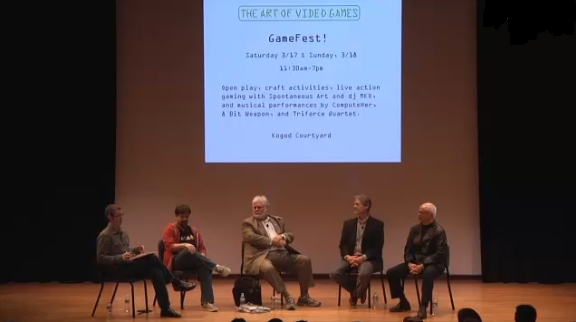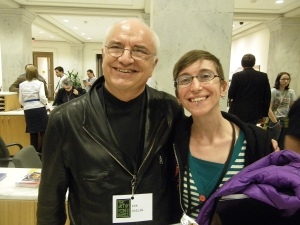
GameFest, a three-day festival to commemorate the opening of the Smithsonian American Art Museum’s “Art of Video Games” exhibit, was held last weekend. The exhibit itself will run from March 16th to September 30th, 2012, with a ten-city tour planned for 2012-2013. But all weekend long, excited participants were able to play games, go to talks by important members of the industry, and attend performances of video game-inspired music. It was inspirational, memorable, and most importantly, a complete blast.
The first panel was on Friday, March 16 at 3 PM. Entitled “Evolution of Video Games: Pioneers,” it hosted such names as Don Daglow, Mike Mika, Rand Miller, and Keith Robinson. Daglow, creator of Neverwinter Nights, “is the only executive in industry history to lead development teams on every generation of video game console.” He’s now the President and Creative Directory of his own company, Daglow Entertainment, LLC. Mika is the Chief Creation Officer for Other Ocean Interactive. He was formerly the Studio Head for Backbone Entertainment at Foundation 9 as well, and has more than 100 games on his resume as an animator, engineer, and writer. Miller, creator of Myst, is the co-founder and CEO of Cyan Worlds. Robinson was a programmer at Mattel Electronics, created Tron Solar Sailer, and supervised production for several platforms, including the Intellivision and Colecovision.
Basically, it was a panel full of heavy hitters, with Robinson owning most of the stage, his raucous voice and friendly personality making the panel feel more like a sit down with some of your closest friends than anything else. The four sat with Chris Melissinos, the guest curator of the exhibit and the author of the book, The Art of Video Games: From Pac-Man to Mass Effect.
Although it must have been intimidating to be onstage with so many of his heroes, Melissinos took it all in stride, laughing and rolling with the jokes of the men, who were obviously comfortable with one another. Daglow and Robinson had worked together at Mattel. Daglow talked about the “university underground,” a name he attributed to the secret world he and his friends lived in, in which they created games on university computers because it was the best hardware they could get access to. The first thing to do, he explained, was to get in good with the security officer overseeing all the computers. Luckily, he was that security officer, so he got to do whatever he wanted.
Rand talked a lot about Myst, and how the success of it was really more of a “right place, right time,” than anything else. He also described the process of building the game within limitations they had, working back and forth from one build to the next, pushing the limits as far as they could go. He also talked about how the creation of a game is really about an amalgam of things that work alone, but work as something completely unique when combined together. (Rand chuckled at one point, admitting that he likes to consider Myst “the best-selling game of the last millennium.”)
 Melissinos continued to bounce around the panel, asking questions and allowing the natural flow of the four veterans to guide the answers. One of the highlights was when they started discussing the fact that the development process gets rougher with new technology at first, and how difficult it is to stay at that level. Once they were able to get used to programming for a specific system, just as they felt they had finally mastered it, the market would be on to the next system, and they’d have to learn it all over again. They referred to this as “hyper evolution,” which sounds extremely accurate when describing the video game development process.
Melissinos continued to bounce around the panel, asking questions and allowing the natural flow of the four veterans to guide the answers. One of the highlights was when they started discussing the fact that the development process gets rougher with new technology at first, and how difficult it is to stay at that level. Once they were able to get used to programming for a specific system, just as they felt they had finally mastered it, the market would be on to the next system, and they’d have to learn it all over again. They referred to this as “hyper evolution,” which sounds extremely accurate when describing the video game development process.
After the talk, members of the audience were allowed and encouraged to get autographs and photographs. I headed over to Daglow, whose chapter I was reading in Gamers at Work, and got my picture taken with him. My friend and I also spoke to Robinson a bit, as well as Activision co-founder David Crane, who was up talking to the panel after it was over. All of the men were friendly, encouraging, and wise, telling funny stories and laughing to each other. Robinson even threw an Intellivision shirt into the crowd. That shirt will either be framed, or will go down in history as the most worn shirt ever.
You can view a webcast of the panel right here:







